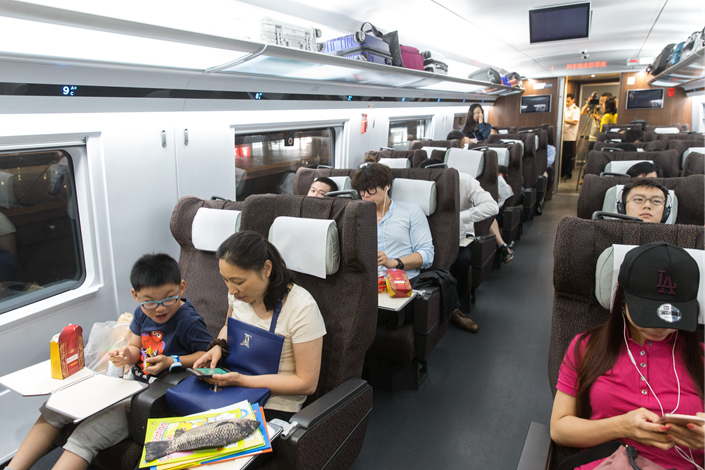China Shows Off New Generation of High-Speed Train

China on Monday debuted its new generation of high-speed trains that feature greater power efficiency, smarter controls and more comforts for passengers.
The new trains also boast 84% of home-made standardized designs, which will gradually replace four incompatible types of bullet trains that are running on 12,000 kilometers (7,500 miles) of track across China. The compatibility problem stems from country’s earlier introduction of different technologies, including from Japan and the EU.
Railway authorities said they expect the newly designed trains to be a major force in China’s exports of high-speed train technology.
Designers have not been touting the speed of the Fuxing trains, which have a designated maximum speed of about 400 kph (248 mph), and cruise at an average speed of 300 kph — similar to existing bullet trains.
Instead, authorities emphasized the more passenger friendly design, such as Wi-Fi service, larger train cars, less noise and more legroom. A new air-conditioning system will also reduce the discomfort that passengers feel in their ears from the change in air pressure when trains pass each other or go through tunnels.
 |
Passengers take the first "Fuxing" train, the new generation of China's high-speed train, in Nanjing on Monday. The train features more space for passengers, wifi service and greater power efficiency. Photo: Visual China |
The trains are also being called safer, as each train will be equipped with more than 2,500 sensors, which will monitor the operation status of various parts on the train, the designers said.
“The new standard trains will also be used in the Indonesia high-speed rail project, making Fuxing a major force of China’s high-speed rail technology exports, He Huawu, chief engineer of China Rail, told the People’s Daily.
China introduced high-speed rail technology in early 2000s from France, Germany, Japan and Canada, and has since been producing bullet trains that are not compatible with one another.
Some trains have different driving platforms; others have a different number of seats in each car. When a train car has a problem, the railway company may have problems finding the right kind of car to replace it, designers said.
Contact reporter Wu Gang (gangwu@caixin.com)

- 1Cover Story: How China Inc. Is Discovering Its New World in Brazil
- 2In Depth: A Lost Masterpiece’s Return Exposes Scandal at a Top Chinese Museum
- 3Offshore Yuan Breaches 7.0 Per Dollar to Hit 15-Month High
- 4China Launches $14 Billion State Fund to Back Strategic Tech Industries
- 5In Depth: Memory Shortage Creates Space for China’s Lesser-Known Chipmakers
- 1Power To The People: Pintec Serves A Booming Consumer Class
- 2Largest hotel group in Europe accepts UnionPay
- 3UnionPay mobile QuickPass debuts in Hong Kong
- 4UnionPay International launches premium catering privilege U Dining Collection
- 5UnionPay International’s U Plan has covered over 1600 stores overseas



